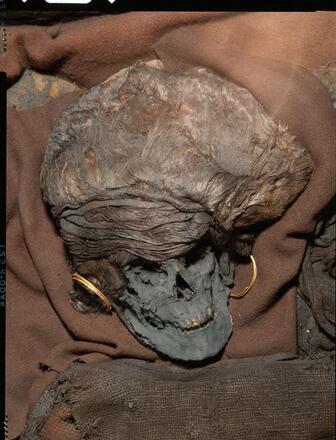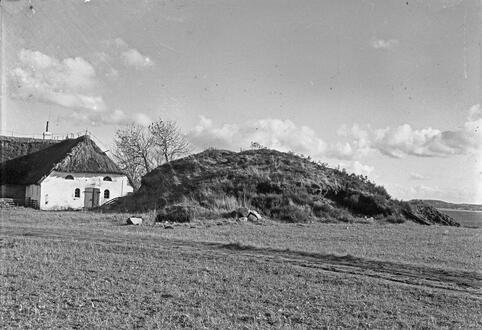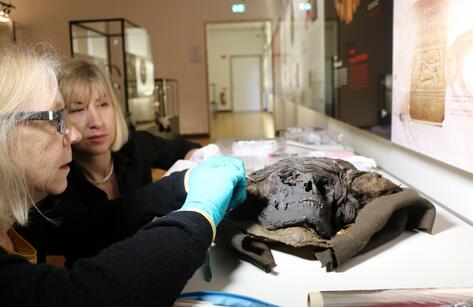The Tale of the Skrydstrup Woman
From:Shanghai Archaeology Forum NetWriter:Date:2017-12-14
The European Bronze Age, often referred to as “The First Golden Age of Europe” was a period of technical innovation, social transformation and the transmission of knowledge all of which were highly stimulated by long distance connections. Due to its importance, the Bronze Age has been extensively investigated by researchers from a great many different fields. However, there are still many key questions that remain unanswered. It follows, therefore, that many of those enigmas center around long-distance exchange and degrees of ancient mobility as integral themes to creating an understanding of Bronze Age society. In Scandinavia, the Nordic Bronze Age (1.700 – 500 BC) has clear and easily recognizable cultural remains in the everyday landscape including the numerous burial barrows, votive depositions and rock carvings. In addition to these impressive cultural remnants, Denmark also possesses a unique collection of exceptionally well-preserved human remains: the well-known oak-coffin people. These ancient men and women represent the elite from a crucial prehistoric period; a period in which the first inklings of modern day Europe began to take shape. These individuals are key to understanding how international trade networks were established and maintained during this important time period in world history. While the presence of exotic artifacts across Northern Europe indicates extensive connections with distant areas, scholars do not know whether those exotic objects were traded from neighboring chiefdom to neighboring chiefdom (low mobility) or whether they were transported by individuals who themselves travelled long trajectories across the Continent (high mobility). Furthermore, it has long been assumed that human mobility in the Nordic Bronze Age was very restricted. Additionally, it was thought that if human mobility took place, then it was most likely performed by male warriors.
Ancient human migration studies are currently witnessing a knowledge revolution brought about mainly by contributions from ancient DNA (aDNA) and strontium isotope analyses (87Sr/86Sr). While aDNA analyses have provided new evidence for migrations on a larger chronological and geographical scale, strontium isotope analyses have yielded information on the migration of single individuals. This last allows for the identification of migrants at specific sites. Until very recently, the prehistoric human mobility of single individuals has been investigated most successfully via the strontium isotope analysis (87Sr/86Sr) of tooth enamel (and sometimes bone). Tooth enamel reveal (e.g. first molar) a geographical origin based on an individual’s average diet consumption over several years. Consequently, these tissues can provide a signature by which it is possible to trace long-term mobility. We have further developed the method so that it may now be applied to hair and nail tissues. These new advancements have created an unprecedented opportunity to investigate short-term human mobility on a monthly basis. Hence, in a single step, the level of detail at which we can study the mobility of single individuals in the past has skyrocketed, moving from an average of several years’ worth of information to a month-by-month resolution. As a result, we are now able to identify and differentiate between short-and long-term mobility for the same individual, thereby furnishing a life-long record of mobility in which it is possible to identify complex travel schedule. These analyses consequently open a new window to the past and have great potential to heighten our knowledge of past social dynamics. The arrival of new techniques with other cutting-edge technologies open up new stories and new about the human remains within museum collections.
The Oak Coffin-burials
The European Bronze Age witness the beginning of state formation and early stages of urbanization. It was a period characterized by the transformation and the transmission of knowledge triggered by elite alliances (among other things). In Denmark’s Early Nordic Bronze Age tradition, elites were buried in oak-coffin graves covered by monumental barrows. The remains of those high-status individuals number among Europe’s best preserved prehistoric human burials. The barrows under which the deceased were interred both protected the graves they covered while also making them more visible in the landscape. This ensured that the memory of the dead would be preserved for coming generations. Throughout the Bronze Age a particular barrow would be repeatedly utilized for subsequent burials. An individual barrow or group of barrows came to constitute a burial site to which people returned and in which they placed their dead for centuries. Today, these barrows -which still remain very visible in the landscape- are vivid memories of a prehistoric society that witnessed the first signs of globalization in Europe.

The Tales of Bronze Age Women Research Project
“Tales of Bronze Age Women” is a threeyear multi-disciplinary research project (2016-2019) that investigates the mobility, identity and social roles of Bronze Age Women in Denmark. The project takes its point of departure in the well preserved oak-coffin graves described above and uses them as a means of investigating some of the most iconic figures and themes from the Nordic Bronze Age. The project came about after the surprising findings of the most iconic of the female oak-coffin graves, the “Egtved Girl” (published in 2015), which provided the first evidence for the long distance mobility of a single individual in prehistory. Moreover, the wool of the Egtved Girl’s garment was shown to have originated from areas far distant to the place where the Egtved Girl was buried.
The immediate question which followed close on the coattails of surprising results from Egtved Girl was whether she presented a unique case or whether other women from that period could have travelled as much and over such great distances as the Egtved Girl did. Although the question might seem impossible to answer, Denmark has what is probably a unique potential for shedding light on this intriguing issue due to the exceptional preservation of the elite women in the oak-coffin burials. Of those, two (namely the Skrydstrup Woman and Borum Eshøj Woman) are particularly well suited. Both finds are contemporary with the Egtved Girl and were buried in a similar manner, i.e. in oak-coffins covered by barrows.
Additionally, “Tales of Bronze Age Women” aims at investigating Bronze Age women from the micro- to the macro- perspective in order to provide new knowledge on multiple aspects of their lives. Hence, the research questions under investigation are as follows:
How mobile were Bronze Age women? A) at the micro-level: High resolution mobility of single Bronze Age elite women; e.g. the Skrydstrup Woman and the Borum Eshøj Woman case studies and, B) at the macro-level: Mobility of a large number of individuals, including men and children for comparison.
Did Bronze Age women have specific roles in long distance trade networks?
Can we identify different identities for Bronze Age women?
These questions are examined through a palette of state-of-the-art archaeometric methods, including radiogenic isotope analyses (87Sr/86Sr), stable isotope analyses (δ13C and δ15N), microscopic analyses, forensic investigations (including CT-scanning), aDNA analyses and contextual archaeological studies. When combined, these methods synergize, offering new and multi-layered information through which we can understand the lives of these elite females and the important socio-dynamic aspects of the society of which they were a part.
The Tale of the Skrydstrup Woman
The Skrydstrup Woman was unearthed in 1935 by archaeological excavation from a burial barrow in southern Denmark. The barrow was constructed during the Nordic Early Bronze Age (1700-1100 BC). Skrydstrup’s barrow was constructed of enormous amounts of turf layers which were laid grass side down and was surrounded by a wall of stones which ringed the base of the barrow. Anoxic waterlogged conditions like those at Skrydstrup’s barrow were created inside the core of some Bronze Age barrows by the formation of ferrous layers which sealed the barrow. This prevented the decomposition of organic remains. Skrydstrup Woman’s barrow was part of a group of eight burial barrows. Skrydstrup Woman’s remains represent the barrow’s primary grave and consist of skeletal as well as soft tissues, which included parts of her cheeks and chin, eyebrows, eyelids, eyelashes and her long hair. Of these, only the hair still remains. Measuring over 60 centimeters, Skrydstrup Woman’s hair is set in a highly complex hairstyle which is atypical for the area. Of the Skrydstrup Woman skeletal tissues, however, a large part still remains and especially her teeth are well preserved.
As was the case for other oak coffin burials, Skrydstrup Woman’s body was placed on an ox-hide wearing a short-sleeved wool blouse decorated with embroidery on the sleeves and at the neckline. She was also equipped with a large square wool textile piece gathered at the top by a belt which covered her from waist to ankle. Additionally, she had a wool cap, a horn comb attached to her belt and a large set of gold spiral rings which lay by her ears.
The first anthropological analyses of Skrydstrup Woman’s remains were made in 1939. Initial odontological investigations showed that all teeth were visible with the exception of the wisdom teeth. The latter were not yet fully developed in the maxilla and had not erupted in the mandible. The teeth are in excellent condition and present no evidence of dental caries or other diseases. Based on these initial analyses, it was concluded that the human remains belonged to a young female whose chronological age was estimated at roughly 20 years at most.
We conducted new anthropological investigations based on the evaluation of the osteological material as well as CT images and 3D visualizations. Sex determination followed standard anthropological techniques and was based on the morphological features of the os coxae, sacrum, the maximum diameter of the femoral head and the appearance of the long bones. Over the course these new investigations, we re-estimated the Skrydstrup Woman’s age at death on the status of the epiphyseal closure of the long bones, the pelvic girdle and vertebral rims as well as on the development and eruption of the teeth. Both of these investigations rendered an estimated age at death of 17-18 years. Our investigations could also confirm that the remains were those of a female individual, indicating that she was very tall for her time (approx. 170 cm).
We conducted strontium isotope analyses on the tooth enamel from one of Skrydstrup Woman’s first molars and one of her third molars (a wisdom tooth). Tooth enamel in humans is resistant to diagenesis and for this reason often used in archaeological investigations to trace human migration. The enamel from the first molar begins to form in utero and finalizes mineralization at c. three years of age, thus providing information about the place of an individual’s childhood origin. By contrast, the crown of the third molar is more variable and represents a longer period of time from the early adolescent years up to approximately 16 years of age. We sampled both these teeth in order to create a long-term timeline related to the places in which the Skrydstrup Woman had lived throughout her life.
Since modern human scalp hair grows an average of c. 1 cm per month, it acts as an archive which can potentially provide high-resolution diachronic information about diet and mobility when investigated by multi-disciplinary tracers. Due to the complexity of Skrydstrup’s hair style and the unique archaeological nature of the Skrydstrup Woman find, the sampling amount needed to perform reliable strontium isotope analyses had to be balanced against conservation needs. For the strontium isotope investigation of the hair, we divided a 42.5 cm long hair shaft into 17 segments covering a total growth period of at least 51 months prior to death.

Our strontium isotope analysis revealed that the Skrydstrup Woman was of nonlocal origin and originated from a place very distant from where she was buried. Some of her scalp hair segments yielded a local strontium isotope signature, while other hair segments have strontium isotope values similar to the elevated, nonlocal signatures recorded in her teeth. Interestingly, an abrupt change in the range of strontium isotope signatures in the hair occurs between two segments which correspond to a period of c. 47 to 42 months prior to Skrydstrup Woman’s death. We posit that this relatively short time period represents the months during which Skrydstrup Woman travelled from a place outside of territorial Denmark to the Skrydstrup area. After this period, the strontium isotope signatures measured on the rest of the hair segments (representing a period of c. > 40 months before death) all yield local signatures. This last is a range that coincides with the site-specific local isotope range of bioavailable strontium for the Skrydstrup area. This implies that, following migration to the Skrydstrup area, Skydstrup Woman most probably resided locally for the remainder of her life.
We also conducted stable isotope analyses of a 12 cm long scalp hair sample in order to provide some incremental data on the Skrydstrup Woman’s diet. The isotopic data based on δ13C and δ15N analyses varies predictably depending on dietary intake and can, therefore, be used to distinguish between reliance on largely terrestrial or marine food resources in past populations. It can also provide information about seasonal variation in diet and can potentially identify physiological impacts. These analyses showed that Skrydstrup had a terrestrial diet with some indications of seasonal variation. An ancient DNA (aDNA) extraction was attempted on a small subsample of hair.

